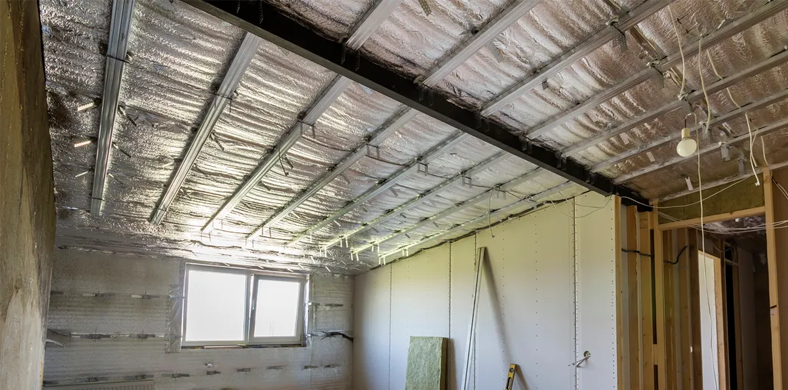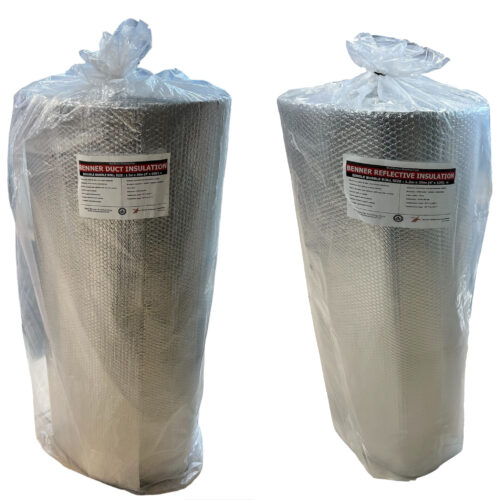Benner Reflective Insulation Single or Double Bubble

Reflective Insulation R-value Information
Reflective insulation and mass insulation are based on the same principle: the ability to stop heat transfer. Reflective insulation reduces heat transfer across air spaces by using surfaces with high thermal reflectance and low emittance, typically involving metalized film and inner substances that trap air. According to the U.S. Department of Energy, “Reflective insulation incorporates radiant barriers — typically highly reflective foils — into insulation systems that can include a variety of backings such as Kraft paper, plastic film, polyethylene bubbles, or cardboard, as well as thermal insulation materials.”
The R-value of reflective insulation measures the effectiveness of the entire system, rather than just the product itself. Measuring the R-value in real-world applications provides a more accurate reflection of its performance compared to laboratory measurements of the product alone.
Reflective insulation can be used in various settings, including:
- Pole barns for housing animals
- Workshops and garages
- Storage units
- Equipment sheds
- Recreational vehicles like motorhomes or campervans
- Inside roof trusses or rafters
- Survival blankets
- Packaging items that need to maintain a specific temperature range during transportation


Reflective Insulation vs. Radiant Barriers
Although the terms reflective insulation and radiant barriers are sometimes used interchangeably, they have distinct differences:
Common Features:
- Both types reflect heat to reduce heat gain and prevent heat loss using an air space barrier.
- They enhance energy efficiency and optimize the building’s HERS rating, lowering expected bills and increasing resale value.
- Installation requires leaving an air-space to increase R-value and achieve the best results.
- Metal surfaces must be kept clean and free of dust for optimal performance.
Differences:
- Radiant Barrier: Made from a single thin layer of aluminum or metalized film, it is typically less than ¼ inch thick. While it reduces heat loss and gain, it is not an insulation material and has no inherent R-value.
- Reflective Insulation: Thicker, consisting of two or more layers of foil forming a blanket, with the middle part made of bubbles, fiberglass, or foam, increasing the R-value. It prevents moisture and blocks condensation, particularly in metal and steel buildings.
Applications of Reflective Insulation
Attics
Reflective insulation in attics prevents radiant heat from entering during summer and escaping during winter, maintaining a comfortable indoor temperature.
Walls
Reflective insulation helps retain heat, reducing energy costs and enhancing thermal efficiency.
Ceilings
Insulating ceilings with reflective material maintains consistent indoor temperatures by preventing heat from escaping.
Floors
Floor insulation is crucial to minimize heat loss and reduce energy consumption, resulting in cost savings.

Installation Guidelines
Attic Installation:
Place insulation material between the attic joists, ensuring complete coverage without compressions.
Secure the insulation with staples or support
Add a second layer of insulation at a 90-degree angle to the first layer for maximum effectiveness.
Roof Installation:
Install the insulation material under the roof rafters with the reflective surface facing the attic.
Leave a gap between the insulation and roof sheathing for proper ventilation and moisture resistance.
Wall and Ceiling Installation:
Position insulation material between wall studs or ceiling joists and secure it with staples, nails, or adhesive.
Add supplementary insulation if necessary to fill gaps or cavities.
Reflective insulation is effective for walls, maintaining thermal insulation, and improving energy efficiency while reducing utility costs.
The thickness of reflective insulation varies from a fraction of an inch to several inches, depending on the application and available space. Thicker materials offer higher insulation.
The lifespan of reflective insulation depends on material quality, installation technique, climate conditions, and regular monitoring. Proper attention to these factors ensures long-lasting performance with low operational costs.
Reflective insulation requires minimal maintenance. Proper installation and periodic inspections ensure efficient functioning.
Reflective insulation is effective in all climates. In hot climates, it reflects radiant heat away, and in cold climates, it prevents heat loss by acting as a radiant heat barrier.
Single vs. Double Bubble Insulation
Single Bubble Insulation
Cost-effective: Ideal for tight spaces requiring insulation.
Temporary use: Can be removed and reused.
Flexible: Suitable for various temporary applications.
Applications: Dog houses, Hot water tanks, Produce boxes, DIY projects, Windshield protectors, Attics, Crawl spaces, Vehicles, Other large-scale building insulation
Double Bubble Insulation
More effective thermal break: Better at reducing radiant heat transfer.
Reduces condensation and frost: Ideal for long-term applications.
Applications: Metal buildings, Pole barns, Tiny homes, Storage units, Crawl spaces, Workshops.
Product Composition
Benner Reflective Insulation products consist of a single or double layer of polyethylene bubbles separating two exterior layers of metalized reflective foil. The polyethylene provides a barrier, making the foil layers effective in reflecting heat and water vapor.
Single Bubble Foil: One layer of bubblesand ideal for smaller-scale projects
Double Bubble Foil: Two layers of bubbles and provides increased effectiveness and reduces radiant heat transfer


